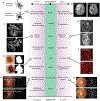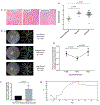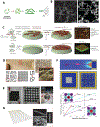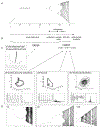A healthy dose of chaos: Using fractal frameworks for engineering higher-fidelity biomedical systems
- PMID: 31376747
- PMCID: PMC6759375
- DOI: 10.1016/j.biomaterials.2019.119363
A healthy dose of chaos: Using fractal frameworks for engineering higher-fidelity biomedical systems
Abstract
Optimal levels of chaos and fractality are distinctly associated with physiological health and function in natural systems. Chaos is a type of nonlinear dynamics that tends to exhibit seemingly random structures, whereas fractality is a measure of the extent of organization underlying such structures. Growing bodies of work are demonstrating both the importance of chaotic dynamics for proper function of natural systems, as well as the suitability of fractal mathematics for characterizing these systems. Here, we review how measures of fractality that quantify the dose of chaos may reflect the state of health across various biological systems, including: brain, skeletal muscle, eyes and vision, lungs, kidneys, tumours, cell regulation, skin and wound repair, bone, vasculature, and the heart. We compare how reports of either too little or too much chaos and fractal complexity can be damaging to normal biological function, and suggest that aiming for the healthy dose of chaos may be an effective strategy for various biomedical applications. We also discuss rising examples of the implementation of fractal theory in designing novel materials, biomedical devices, diagnostics, and clinical therapies. Finally, we explain important mathematical concepts of fractals and chaos, such as fractal dimension, criticality, bifurcation, and iteration, and how they are related to biology. Overall, we promote the effectiveness of fractals in characterizing natural systems, and suggest moving towards using fractal frameworks as a basis for the research and development of better tools for the future of biomedical engineering.
Keywords: Biomedical engineering; Chaos; Fractals; Health; Pathophysiology; Tissue engineering.
Copyright © 2019 Elsevier Ltd. All rights reserved.
Figures







Similar articles
-
[Chaos and fractals and their applications in electrocardial signal research].Sheng Wu Yi Xue Gong Cheng Xue Za Zhi. 2009 Jun;26(3):676-80. Sheng Wu Yi Xue Gong Cheng Xue Za Zhi. 2009. PMID: 19634696 Review. Chinese.
-
Cardiac interbeat interval dynamics from childhood to senescence : comparison of conventional and new measures based on fractals and chaos theory.Circulation. 1999 Jul 27;100(4):393-9. doi: 10.1161/01.cir.100.4.393. Circulation. 1999. PMID: 10421600
-
Deterministic chaos and fractal complexity in the dynamics of cardiovascular behavior: perspectives on a new frontier.Open Cardiovasc Med J. 2009 Sep 10;3:110-23. doi: 10.2174/1874192400903010110. Open Cardiovasc Med J. 2009. PMID: 19812706 Free PMC article.
-
Fractality and a wavelet-chaos-neural network methodology for EEG-based diagnosis of autistic spectrum disorder.J Clin Neurophysiol. 2010 Oct;27(5):328-33. doi: 10.1097/WNP.0b013e3181f40dc8. J Clin Neurophysiol. 2010. PMID: 20844443
-
[Chaos and fractals. Are these of interest to medical science?].Tidsskr Nor Laegeforen. 1993 Dec 10;113(30):3678-85. Tidsskr Nor Laegeforen. 1993. PMID: 8278950 Review. Norwegian.
Cited by
-
A novel chaotic system with one absolute term: stability, ultimate boundedness, and image encryption.Heliyon. 2024 Sep 3;11(1):e37239. doi: 10.1016/j.heliyon.2024.e37239. eCollection 2025 Jan 15. Heliyon. 2024. PMID: 39958727 Free PMC article.
-
Fractal analysis of rat dermal tissue in the different injury states.Int Wound J. 2022 Aug;19(5):1016-1022. doi: 10.1111/iwj.13698. Epub 2021 Oct 7. Int Wound J. 2022. PMID: 34617391 Free PMC article.
-
Fractal Design Boosts Extrusion-Based 3D Printing of Bone-Mimicking Radial-Gradient Scaffolds.Research (Wash D C). 2021 Nov 23;2021:9892689. doi: 10.34133/2021/9892689. eCollection 2021. Research (Wash D C). 2021. PMID: 34909694 Free PMC article.
-
Symmetry and asymmetry in atherosclerosis.Int J Occup Med Environ Health. 2023 Dec 15;36(6):693-703. doi: 10.13075/ijomeh.1896.02171. Epub 2023 Oct 2. Int J Occup Med Environ Health. 2023. PMID: 37791506 Free PMC article. Review.
-
Principles Entailed by Complexity, Crucial Events, and Multifractal Dimensionality.Entropy (Basel). 2025 Feb 26;27(3):241. doi: 10.3390/e27030241. Entropy (Basel). 2025. PMID: 40149165 Free PMC article.
References
-
- Mandelbrot BB The fractal geometry of nature. (W.H. Freeman, 1983).
-
- Peitgen H-O, Jürgens H & Saupe D Chaos and Fractals: New Frontiers of Science. (Springer Science & Business Media, 2006).
-
- Di Ieva A, Le Reste P-J, Carsin-Nicol B, Ferre J-C & Cusimano MD Diagnostic Value of Fractal Analysis for the Differentiation of Brain Tumors Using 3-Tesla Magnetic Resonance Susceptibility-Weighted Imaging. Neurosurgery 79, 839–846 (2016). - PubMed
Publication types
MeSH terms
Substances
Grants and funding
LinkOut - more resources
Full Text Sources

